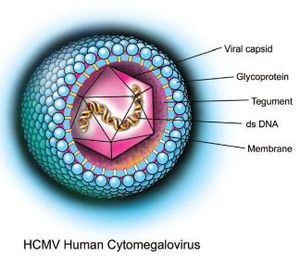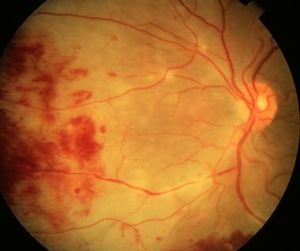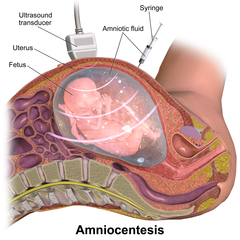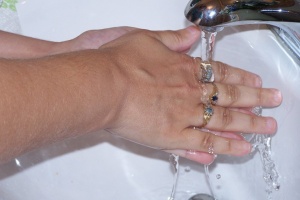Cytomegalovirus (CMV) Infection: Difference between revisions
No edit summary |
No edit summary |
||
| (22 intermediate revisions by 5 users not shown) | |||
| Line 1: | Line 1: | ||
<div class="editorbox"> | |||
'''Original Editors '''- [[Pathophysiology of Complex Patient Problems|Students from Bellarmine University's Pathophysiology of Complex Patient Problems project.]] | '''Original Editors '''- [[Pathophysiology of Complex Patient Problems|Students from Bellarmine University's Pathophysiology of Complex Patient Problems project.]] | ||
| Line 6: | Line 5: | ||
</div> | </div> | ||
== Description == | == Description == | ||
[[Image:Cmv.jpg|right|frameless]]Cytomegalovirus (CMV) Infection, also known as herpesvirus type 5, is a common virus belonging to the herpes family that affects a variety of individuals across the lifespan.<ref name="Goodman">Goodman C, Fuller K. Pathology: Implications for the Physical Therapist. 3rd ed. St. Louis, Missouri: Saunders Elsevier, 2009. 336-337.</ref> It is currently the '''leading cause of congenital infections in the world''', and can cause long term consequences such as hearing loss, visual deficits, and cognitive delays.<ref name="Pedclerk">The University of Chicago. Cytomegalovirus (CMV). https://pedclerk.bsd.uchicago.edu/page/cytomegalovirus-cmv (accessed 04 March 2016).</ref><ref name="Dollard">Dollard S, Grosse S, Ross D. New estimates of the prevalence of neurological and sensory sequelae and mortality associated with congenital cytomegalovirus infection. Reviews In Medical Virology [serial on the Internet]. (2007, Sep), [cited April 4, 2016]; 17(5): 355-363. Available from: MEDLINE.</ref> It is frequently acquired in late childhood or early adulthood, and is rarely symptomatic, except in the immunocompromised. | |||
Cytomegalovirus (CMV) Infection, also known as herpesvirus type 5, is a common virus belonging to the herpes family that affects a variety of individuals across the lifespan.<ref name="Goodman">Goodman C, | |||
<br> | <br> | ||
<ref name="Pedclerk" /><br> | <ref name="Pedclerk" /><br> | ||
== Prevalence == | == Prevalence == | ||
[[File:CMVmap.jpg|right|frameless|400x400px]] | |||
Reported incidence of CMV '''varies'''. Recent evidence suggests that one percent of newborns have the virus, as well as eighty percent of people over 35 years of age.<ref name="Goodman" /> Other studies report that 50-80% of people are infected with the virus, and up to 90% or more in developing countries.<ref name="Pedclerk" /> After infection, the virus may remain latent within monocytes, frequently causing it to be difficult to detect.<ref name="Guo">Guo R, Gebreab F, Tang E, Piao Z, Lee S, Perez M. Cutaneous Ulcer as Leading Symptom of Systemic Cytomegalovirus Infection. Case Reports In Infectious Diseases [serial on the Internet]. (2015, Feb 16), [cited April 4, 2016]; 20151-4. Available from: Academic Search Complete.</ref> Therefore, true prevalence may be different than numbers reported.<br> | |||
R: CMV seroprevalence (shaded). Congenital CMV birth prevelance (circles).<ref name="Pedclerk" /> | |||
CMV | |||
== Characteristics/Clinical Presentation == | == Characteristics/Clinical Presentation == | ||
[[File:Blue.jpg|right|frameless]] | |||
Cytomegalovirus rarely presents with symptoms and may be be left undetected. Like other viruses in the herpes family, CMV resides dormant in the body.<ref name="Ohlin">Ohlin M, Söderberg-Nauclér C. Human antibody technology and the development of antibodies against cytomegalovirus. Molecular Immunology [serial on the Internet]. (2015, Oct), [cited April 4, 2016]; 67(2 Pt A): 153-170. Available from: MEDLINE.</ref> After dormancy, it can be reactivated by some trigger, which commonly includes immunosuppression, stress, and medication use.<ref name="Guo" /> When active, individuals with CMV may show signs of lower extremity weakness which can later result in flaccid paralysis due to nerve root damage.<ref name="Goodman" /> Cytomegalovirus can also present with a variety of other symptoms such as:<ref name="Ohlin" /><ref name="Scripps">Scripps. CMV - pneumonia. https://www.scripps.org/articles/3053-cmv-pneumonia (accessed 04 March 2016).</ref> | Cytomegalovirus '''rarely presents with symptoms''' and may be be left undetected. Like other viruses in the herpes family, CMV resides dormant in the body.<ref name="Ohlin">Ohlin M, Söderberg-Nauclér C. Human antibody technology and the development of antibodies against cytomegalovirus. Molecular Immunology [serial on the Internet]. (2015, Oct), [cited April 4, 2016]; 67(2 Pt A): 153-170. Available from: MEDLINE.</ref> After dormancy, it can be reactivated by some trigger''',''' which commonly includes immunosuppression, stress, and medication use.<ref name="Guo" /> When active, individuals with CMV may show signs of lower extremity weakness which can later result in flaccid paralysis due to nerve root damage.<ref name="Goodman" /> Cytomegalovirus can also present with a variety of other symptoms such as:<ref name="Ohlin" /><ref name="Scripps">Scripps. CMV - pneumonia. https://www.scripps.org/articles/3053-cmv-pneumonia (accessed 04 March 2016).</ref> | ||
*Cough | *Cough | ||
| Line 39: | Line 30: | ||
*Night sweats<br> | *Night sweats<br> | ||
*Upper Respiratory Infection | *Upper Respiratory Infection | ||
*Rash (children) | *Rash (children) see R | ||
*Jaundice (children) | *Jaundice (children)<ref name="Pedclerk" /> | ||
== Associated Co-morbidities == | == Associated Co-morbidities == | ||
Cytomegalovirus is often associated with systemic diseases during times of immunosuppression manifesting as:<ref name="Guo" /> | Cytomegalovirus is often associated with '''systemic diseases''' during times of immunosuppression manifesting as:<ref name="Guo" /> | ||
[[File:Retinitis.jpg|right|frameless]] | |||
*Hepatitis | *[[Hepatitis A, B, C|Hepatitis]] | ||
*Colitis | *Colitis | ||
* | *Pneumo<nowiki/>nitis | ||
*Esophagitis | *Esophagitis | ||
*Bone marrow suppression | *Bone marrow suppression | ||
*Image R - CMV Retinitis<ref name="Altaweel">Altaweel, M, MD, FRCSC, Youssef, P, MD. CMV Retinitis. http://emedicine.medscape.com/article/1227228-overview (accessed 04 March 2016).</ref> | |||
CMV Retinitis<ref name="Altaweel">Altaweel, M, MD, FRCSC, Youssef, P, MD. CMV Retinitis. http://emedicine.medscape.com/article/1227228-overview (accessed 04 March 2016).</ref> | |||
== Medications == | == Medications == | ||
The most common treatment for CMV includes antiviral use, such as '''Ganciclovir''' (intravenous) and '''Valganciclovir''' (oral). Less common medications include '''Foscarnet''' and '''Cidofovir'''.<ref name="Goodman" /> Ganciclovir works by inhibiting the replication of viral DNA by ganciclovir-5’-triphosphate, which involves inhibition of the viral DNA polymerase.<ref name="Matthews">Matthews T, Boehme R. Antiviral activity and mechanism of action of ganciclovir. Reviews Of Infectious Diseases [serial on the Internet]. (1988, July), [cited April 5, 2016]; 10 Suppl 3S490-S494. Available from: MEDLINE.</ref> The use of two vaccines is currently being investigated in phase II and phase III clinical trials in healthy, postpartum females and transplant recipients.<ref name="Rieder">Rieder F, Steininger C. Cytomegalovirus vaccine: phase II clinical trial results. Clinical Microbiology & | The most common treatment for CMV includes [[Antiviral Drugs|antiviral]] use, such as '''Ganciclovir''' (intravenous) and '''Valganciclovir''' (oral). Less common medications include '''Foscarnet''' and '''Cidofovir'''.<ref name="Goodman" /> Ganciclovir works by inhibiting the replication of viral DNA by ganciclovir-5’-triphosphate, which involves inhibition of the viral DNA polymerase.<ref name="Matthews">Matthews T, Boehme R. Antiviral activity and mechanism of action of ganciclovir. Reviews Of Infectious Diseases [serial on the Internet]. (1988, July), [cited April 5, 2016]; 10 Suppl 3S490-S494. Available from: MEDLINE.</ref> The use of two vaccines is currently being investigated in phase II and phase III clinical trials in healthy, postpartum females and transplant recipients.<ref name="Rieder">Rieder F, Steininger C. Cytomegalovirus vaccine: phase II clinical trial results. Clinical Microbiology & Infection [serial on the Internet]. (2014, May 2), [cited April 4, 2016]; 2095-102. Available from: Academic Search Complete.</ref> More research must be completed in this area to determine if CMV vaccinations are effective. Individuals who have the disease but are asymptomatic are not typically treated. <br> | ||
== Diagnostic Tests/Lab Tests/Lab Values == | == Diagnostic Tests/Lab Tests/Lab Values == | ||
[[Image:Amniocentesis.png|right|frameless]]There are different diagnostic processes for adults with CMV and for children with CMV. Fetal diagnosis is made by assessing the DNA in the amniotic fluid by '''amniocentesis'''. Prenatal ultrasounds or MRI imaging of the fetal brain or fetal blood biochemistry can help determine the overall health of the baby to determine an appropropriate prognosis.<ref name="Desveaux">Desveaux C, Klein J, Leruez-Ville M, Ramirez-Torres A, Lacroix C, Ville Y, et al. Identification of Symptomatic Fetuses Infected with Cytomegalovirus Using Amniotic Fluid Peptide Biomarkers. Plos Pathogens [serial on the Internet]. (2016, Jan 25), [cited April 5, 2016]; 14(1): 1-21. Available from: Academic Search Complete.</ref> This is useful because diagnosis does not equate to expression of symptoms. Lab values such as thrombocytopenia and high serum levels of beta-2-microglobulin can also aide in developing a prognosis.These values can be determined after '''cordocentesis''', which detects abnormalities in the fetal blood.<ref name="Desveaux" /> After birth, diagnosis is made by a positive urine culture or polymerase chain reaction.<ref name="Bilavsky">Bilavsky E, Schwarz M, Bar-Sever Z, Pardo J, Amir J. Hepatic involvement in congenital cytomegalovirus infection - infrequent yet significant. Journal Of Viral Hepatitis [serial on the Internet]. (2015, Sep), [cited April 4, 2016]; 22(9): 763-768. Available from: MEDLINE.</ref> As an adult, diagnosis is made by detection CMV ImM in blood or the protein pp65 antigen by a PCR test.<ref name="Lazzarotto">Lazzarotto T, Guerra B, Lanari M, Gabrielli L, Landini M. New advances in the diagnosis of congenital cytomegalovirus infection. Journal Of Clinical Virology: The Official Publication Of The Pan American Society For Clinical Virology [serial on the Internet]. (2008, Mar), [cited April 5, 2016]; 41(3): 192-197. Available from: MEDLINE.</ref><ref name="Gonzalez" /><ref name="Blaus">Blaus, B. Amniocentesis. https://commons.wikimedia.org/wiki/File:Amniocentesis.png (accessed 07 March 2016).</ref> | |||
There are different diagnostic processes for adults with CMV and for children with CMV. Fetal diagnosis is made by assessing the DNA in the amniotic fluid by '''amniocentesis'''. Prenatal ultrasounds or MRI imaging of the fetal brain or fetal blood biochemistry can help determine the overall health of the baby to determine an appropropriate prognosis.<ref name="Desveaux">Desveaux C, Klein J, Leruez-Ville M, Ramirez-Torres A, Lacroix C, Ville Y, et al. Identification of Symptomatic Fetuses Infected with Cytomegalovirus Using Amniotic Fluid Peptide Biomarkers. Plos Pathogens [serial on the Internet]. (2016, Jan 25), [cited April 5, 2016]; 14(1): 1-21. Available from: Academic Search Complete.</ref> This is useful because diagnosis does not equate to expression of symptoms. Lab values such as thrombocytopenia and high serum levels of beta-2-microglobulin can also aide in developing a prognosis.These values can be determined after '''cordocentesis''', which detects abnormalities in the fetal blood.<ref name="Desveaux" /> After birth, diagnosis is made by a positive urine culture or polymerase chain reaction.<ref name="Bilavsky">Bilavsky E, Schwarz M, Bar-Sever Z, Pardo J, Amir J. Hepatic involvement in congenital cytomegalovirus infection - infrequent yet significant. Journal Of Viral Hepatitis [serial on the Internet]. (2015, Sep), [cited April 4, 2016]; 22(9): 763-768. Available from: MEDLINE.</ref> As an adult, diagnosis is made by detection CMV ImM in blood or the protein pp65 antigen by a PCR test.<ref name="Lazzarotto">Lazzarotto T, Guerra B, Lanari M, Gabrielli L, Landini M. New advances in the diagnosis of congenital cytomegalovirus infection. Journal Of Clinical Virology: The Official Publication Of The Pan American Society For Clinical Virology [serial on the Internet]. (2008, Mar), [cited April 5, 2016]; 41(3): 192-197. Available from: MEDLINE.</ref><ref name="Gonzalez" /> | |||
<ref name="Blaus">Blaus, B. Amniocentesis. https://commons.wikimedia.org/wiki/File:Amniocentesis.png (accessed 07 March 2016).</ref> | |||
== Etiology/Causes == | == Etiology/Causes == | ||
CMV is transmitted through exposure to bodily fluids such as:<ref name="Goodman" /> | CMV is transmitted through exposure to '''bodily fluids''' such as:<ref name="Goodman" /> | ||
*Urine | *Urine | ||
| Line 90: | Line 61: | ||
*Breast milk | *Breast milk | ||
CMV can also travel through the placenta from mother to child | CMV can also travel through the '''placenta''' from mother to child. Although less common, CMV can be transmitted during '''organ transplants''' and '''blood transfusions'''. Transmission from person to person '''via the hands '''can also occur, although evidence is inconclusive as to whether health care workers that care for affected individuals are at a greater risk for contracting the virus.<ref name="Goodman" /> | ||
== Systemic Involvement == | == Systemic Involvement == | ||
| Line 96: | Line 67: | ||
Systems involved with and affected by Cytomegalovirus: | Systems involved with and affected by Cytomegalovirus: | ||
*Reticuloendothelial system (liver - hepatitis and cholestatic disease in infants)<ref name="Bilavsky" /> | *'''Reticuloendothelial system''' (liver - hepatitis and cholestatic disease in infants)<ref name="Bilavsky" /> | ||
*Central Nervous System (microcephalus, chorioretinitis, meningitis, encephalitis, myelitis, nerve palsies, seizures, or coma)<ref name="Bilavsky" /><ref name="Lazzarotto" /><ref name="Gonzalez" /> | *'''Central Nervous System''' (microcephalus, chorioretinitis, meningitis, encephalitis, myelitis, nerve palsies, seizures, or coma)<ref name="Bilavsky" /><ref name="Lazzarotto" /><ref name="Gonzalez" /> | ||
*Auditory and Ocular Systems - hearing and vision loss<ref name="Bilavsky" /> | *'''Auditory and Ocular Systems''' - hearing and vision loss<ref name="Bilavsky" /> | ||
*Inflammation associated with pneumonitis, retinitis, colitis<ref name="Lazzarotto" />< | *Inflammation associated with pneumonitis, retinitis, colitis<ref name="Lazzarotto" /> | ||
== Medical Management == | |||
Individuals do not often seek treatment for CMV, especially when asymptomatic.<ref name="Gonzalez" /> | |||
'''No cure''' for CMV, those individuals showing symptoms are primarily treated with '''antivirals''' such as such as Ganciclovir (intravenous) and Valganciclovir (oral).<ref name="Goodman" /><ref name="Gonzalez" /> (see Medication). | |||
= | '''Prevention''' is important in order avoid the transmission of CMV, such practicing regular [[Hand Hygiene|hand washing]]<ref name="Goodman" />. | ||
Associated comorbidities are medically managed based on condition. | |||
Proper hand hygiene includes the the following:<ref name="Handwashing">Center for Disease Control and Prevention. Handwashing: Clean Hands Save Lives. http://www.cdc.gov/handwashing/when-how-handwashing.html (accesed 04 March 2016).</ref> | |||
*Wet your hands with clean, running water (warm or cold), turn off the tap, and apply soap. | *Wet your hands with clean, running water (warm or cold), turn off the tap, and apply soap. | ||
| Line 109: | Line 88: | ||
*Scrub your hands for at least 20 seconds. Need a timer? Hum the "Happy Birthday" song from beginning to end twice. | *Scrub your hands for at least 20 seconds. Need a timer? Hum the "Happy Birthday" song from beginning to end twice. | ||
*Rinse your hands well under clean, running water. | *Rinse your hands well under clean, running water. | ||
*Dry your hands using a clean towel or air dry them. | *Dry your hands using a clean towel or air dry them. | ||
== Physical Therapy Management | == Physical Therapy Management == | ||
There has been little research on the indications of the use of physical therapy for those with cytomegalovirus. Typically those diagnosed with CMV willl not receive treatment unless immunocompromised.<ref name="Gonzalez">Gonzalez, S. Cytomegalovirus (CMV) Infection. http://www.medicinenet.com/cytomegalovirus_cmv/page4.htm (accessed 07 March 2016).</ref> The virus is typically managed with the appropriate medications that are listed above. Physical therapy may be useful to treat the physical, neurological and cognitive impairments that are associated with cytomegalovirus. There can be motor deficits and cognitive delays that occur as a result of the virus that physical therapy can address to help improve the overall function of the individual. | There has been little research on the indications of the use of physical therapy for those with cytomegalovirus. Typically those diagnosed with CMV '''willl not receive treatment''' unless immunocompromised.<ref name="Gonzalez">Gonzalez, S. Cytomegalovirus (CMV) Infection. http://www.medicinenet.com/cytomegalovirus_cmv/page4.htm (accessed 07 March 2016).</ref> The virus is typically managed with the '''appropriate medications''' that are listed above. Physical therapy may be useful to treat the physical, neurological and cognitive impairments that are associated with cytomegalovirus. There can be motor deficits and cognitive delays that occur as a result of the virus that physical therapy can address to help '''improve the overall function''' of the individual. | ||
== Differential Diagnosis == | == Differential Diagnosis == | ||
Cytomegalovirus is frequently misdiagnosed as mononucleosis or | Cytomegalovirus is frequently misdiagnosed as '''[[Epstein-Barr Virus|mononucleosis aka Epstein-Barr Virus]]''' or '''influenza''' due to symptoms such as muscle aches, fever, enlarged lymph nodes and/or spleen, loss of appetite, and fatigue.<ref name="Gonzalez" /><ref name="Differential">Center for Disease Control and Prevention. Cytomegalovirus (CMV) and Cytomegalovirus Infection. http://www.cdc.gov/cmv/testing-diagnosis.html (accesed 04 March 2016).</ref> Any immunocompromised or pregnant individual experiencing constitutional symptoms (fever, chills, fatigue, loss of appetite, etc) should seek medical attention immediately.<br> | ||
== Case Reports/ Case Studies == | == Case Reports/ Case Studies == | ||
| Line 131: | Line 110: | ||
[http://eds.a.ebscohost.com/ehost/pdfviewer/pdfviewer?sid=e5d981a1-f161-4976-a34a-e256ff4c9867%40sessionmgr4003&vid=9&hid=4110 http://eds.a.ebscohost.com/ehost/pdfviewer/pdfviewer?sid=e5d981a1-f161-4976-a34a-e256ff4c9867%40sessionmgr4003&vid=9&hid=4110] | [http://eds.a.ebscohost.com/ehost/pdfviewer/pdfviewer?sid=e5d981a1-f161-4976-a34a-e256ff4c9867%40sessionmgr4003&vid=9&hid=4110 http://eds.a.ebscohost.com/ehost/pdfviewer/pdfviewer?sid=e5d981a1-f161-4976-a34a-e256ff4c9867%40sessionmgr4003&vid=9&hid=4110] | ||
== Resources | == Resources == | ||
According to the Centers for Disease Control and Prevention, pregnant women can reduce their risk of contracting CMV by taking the following precauations:<ref name="Washing">Centers for Disease Control and Prevention. Preventing Congenital CMV Infection. http://www.cdc.gov/cmv/prevention.html (accessed 07 March 2016).</ref> | According to the Centers for Disease Control and Prevention, pregnant women can reduce their risk of contracting CMV by taking the following '''precauations''':<ref name="Washing">Centers for Disease Control and Prevention. Preventing Congenital CMV Infection. http://www.cdc.gov/cmv/prevention.html (accessed 07 March 2016).</ref> | ||
Thoroughly wash hands with soap and water for 15–20 s, especially after: <br>Changing | Thoroughly wash hands with soap and water for 15–20 s, especially after: <br>Changing diapers<br>Feeding a young child<br>Wiping a young child’s nose or drool <br>Handling children’s toys | ||
<br>Do not share food, drinks or utensils used by young children.<br>Do not put a child’s | <br>Do not share food, drinks or utensils used by young children.<br>Do not put a child’s pacificers in your mouth.<br>Do not share a toothbrush with a young child.<br>Avoid contact with saliva when kissing a child.<br>Clean toys, countertops and other surfaces that come into contact with children’s urine or saliva. <br><br> | ||
[[Image:Handwashing.jpg|300x250px]] | [[Image:Handwashing.jpg|300x250px]] | ||
Handwashing<ref name="Angelsharum">Angelsharum. https://commons.wikimedia.org/wiki/File:Handwashing.jpg (accessed 07 March 2016).</ref> | Handwashing<ref name="Angelsharum">Angelsharum. https://commons.wikimedia.org/wiki/File:Handwashing.jpg (accessed 07 March 2016).</ref> | ||
== References == | == References == | ||
<references /> | <references /> | ||
[[Category:Bellarmine_Student_Project]] | [[Category:Bellarmine_Student_Project]] | ||
[[Category:Communicable Diseases]] | |||
Latest revision as of 08:44, 5 January 2022
Original Editors - Students from Bellarmine University's Pathophysiology of Complex Patient Problems project.
Top Contributors - Elizabeth Levay, Kim Jackson, Lucinda hampton, WikiSysop, Nupur Smit Shah, 127.0.0.1 and Elaine Lonnemann
Description[edit | edit source]
Cytomegalovirus (CMV) Infection, also known as herpesvirus type 5, is a common virus belonging to the herpes family that affects a variety of individuals across the lifespan.[1] It is currently the leading cause of congenital infections in the world, and can cause long term consequences such as hearing loss, visual deficits, and cognitive delays.[2][3] It is frequently acquired in late childhood or early adulthood, and is rarely symptomatic, except in the immunocompromised.
Prevalence[edit | edit source]
Reported incidence of CMV varies. Recent evidence suggests that one percent of newborns have the virus, as well as eighty percent of people over 35 years of age.[1] Other studies report that 50-80% of people are infected with the virus, and up to 90% or more in developing countries.[2] After infection, the virus may remain latent within monocytes, frequently causing it to be difficult to detect.[4] Therefore, true prevalence may be different than numbers reported.
R: CMV seroprevalence (shaded). Congenital CMV birth prevelance (circles).[2]
Characteristics/Clinical Presentation[edit | edit source]
Cytomegalovirus rarely presents with symptoms and may be be left undetected. Like other viruses in the herpes family, CMV resides dormant in the body.[5] After dormancy, it can be reactivated by some trigger, which commonly includes immunosuppression, stress, and medication use.[4] When active, individuals with CMV may show signs of lower extremity weakness which can later result in flaccid paralysis due to nerve root damage.[1] Cytomegalovirus can also present with a variety of other symptoms such as:[5][6]
- Cough
- Fatigue
- Fever
- Malaise
- Loss of appetite
- Joint pain
- Shortness of breath
- Dyspnea
- Night sweats
- Upper Respiratory Infection
- Rash (children) see R
- Jaundice (children)[2]
Associated Co-morbidities[edit | edit source]
Cytomegalovirus is often associated with systemic diseases during times of immunosuppression manifesting as:[4]
Medications[edit | edit source]
The most common treatment for CMV includes antiviral use, such as Ganciclovir (intravenous) and Valganciclovir (oral). Less common medications include Foscarnet and Cidofovir.[1] Ganciclovir works by inhibiting the replication of viral DNA by ganciclovir-5’-triphosphate, which involves inhibition of the viral DNA polymerase.[8] The use of two vaccines is currently being investigated in phase II and phase III clinical trials in healthy, postpartum females and transplant recipients.[9] More research must be completed in this area to determine if CMV vaccinations are effective. Individuals who have the disease but are asymptomatic are not typically treated.
Diagnostic Tests/Lab Tests/Lab Values[edit | edit source]
There are different diagnostic processes for adults with CMV and for children with CMV. Fetal diagnosis is made by assessing the DNA in the amniotic fluid by amniocentesis. Prenatal ultrasounds or MRI imaging of the fetal brain or fetal blood biochemistry can help determine the overall health of the baby to determine an appropropriate prognosis.[10] This is useful because diagnosis does not equate to expression of symptoms. Lab values such as thrombocytopenia and high serum levels of beta-2-microglobulin can also aide in developing a prognosis.These values can be determined after cordocentesis, which detects abnormalities in the fetal blood.[10] After birth, diagnosis is made by a positive urine culture or polymerase chain reaction.[11] As an adult, diagnosis is made by detection CMV ImM in blood or the protein pp65 antigen by a PCR test.[12][13][14]
Etiology/Causes[edit | edit source]
CMV is transmitted through exposure to bodily fluids such as:[1]
- Urine
- Feces
- Blood
- Semen
- Urogenital secretions
- Breast milk
CMV can also travel through the placenta from mother to child. Although less common, CMV can be transmitted during organ transplants and blood transfusions. Transmission from person to person via the hands can also occur, although evidence is inconclusive as to whether health care workers that care for affected individuals are at a greater risk for contracting the virus.[1]
Systemic Involvement[edit | edit source]
Systems involved with and affected by Cytomegalovirus:
- Reticuloendothelial system (liver - hepatitis and cholestatic disease in infants)[11]
- Central Nervous System (microcephalus, chorioretinitis, meningitis, encephalitis, myelitis, nerve palsies, seizures, or coma)[11][12][13]
- Auditory and Ocular Systems - hearing and vision loss[11]
- Inflammation associated with pneumonitis, retinitis, colitis[12]
Medical Management[edit | edit source]
Individuals do not often seek treatment for CMV, especially when asymptomatic.[13]
No cure for CMV, those individuals showing symptoms are primarily treated with antivirals such as such as Ganciclovir (intravenous) and Valganciclovir (oral).[1][13] (see Medication).
Prevention is important in order avoid the transmission of CMV, such practicing regular hand washing[1].
Associated comorbidities are medically managed based on condition.
Proper hand hygiene includes the the following:[15]
- Wet your hands with clean, running water (warm or cold), turn off the tap, and apply soap.
- Lather your hands by rubbing them together with the soap. Be sure to lather the backs of your hands, between your fingers, and under your nails.
- Scrub your hands for at least 20 seconds. Need a timer? Hum the "Happy Birthday" song from beginning to end twice.
- Rinse your hands well under clean, running water.
- Dry your hands using a clean towel or air dry them.
Physical Therapy Management[edit | edit source]
There has been little research on the indications of the use of physical therapy for those with cytomegalovirus. Typically those diagnosed with CMV willl not receive treatment unless immunocompromised.[13] The virus is typically managed with the appropriate medications that are listed above. Physical therapy may be useful to treat the physical, neurological and cognitive impairments that are associated with cytomegalovirus. There can be motor deficits and cognitive delays that occur as a result of the virus that physical therapy can address to help improve the overall function of the individual.
Differential Diagnosis[edit | edit source]
Cytomegalovirus is frequently misdiagnosed as mononucleosis aka Epstein-Barr Virus or influenza due to symptoms such as muscle aches, fever, enlarged lymph nodes and/or spleen, loss of appetite, and fatigue.[13][16] Any immunocompromised or pregnant individual experiencing constitutional symptoms (fever, chills, fatigue, loss of appetite, etc) should seek medical attention immediately.
Case Reports/ Case Studies[edit | edit source]
Simioni C, Sanchez Oliveira R, Moscovi T, D´Agostini Deutsch A, Cordioli E, Santos E. Twin pregnancy and congenital cytomegalovirus: Case report and review. Journal Of Maternal-Fetal & Neonatal Medicine [serial on the Internet]. (2013, Apr), [cited April 4, 2016]; 26(6): 622-624. Available from: Academic Search Complete.
Kaul D, Stoelben S, Cober E, Ojo T, Sandusky E, Rubsamen-Schaeff H, et al. First report of successful treatment of multidrug-resistant cytomegalovirus disease with the novel anti-CMV compound AIC246. American Journal Of Transplantation: Official Journal Of The American Society Of Transplantation And The American Society Of Transplant Surgeons [serial on the Internet]. (2011, May), [cited April 4, 2016]; 11(5): 1079-1084. Available from: MEDLINE.
Resources[edit | edit source]
According to the Centers for Disease Control and Prevention, pregnant women can reduce their risk of contracting CMV by taking the following precauations:[17]
Thoroughly wash hands with soap and water for 15–20 s, especially after:
Changing diapers
Feeding a young child
Wiping a young child’s nose or drool
Handling children’s toys
Do not share food, drinks or utensils used by young children.
Do not put a child’s pacificers in your mouth.
Do not share a toothbrush with a young child.
Avoid contact with saliva when kissing a child.
Clean toys, countertops and other surfaces that come into contact with children’s urine or saliva.
Handwashing[18]
References[edit | edit source]
- ↑ 1.0 1.1 1.2 1.3 1.4 1.5 1.6 1.7 Goodman C, Fuller K. Pathology: Implications for the Physical Therapist. 3rd ed. St. Louis, Missouri: Saunders Elsevier, 2009. 336-337.
- ↑ 2.0 2.1 2.2 2.3 2.4 The University of Chicago. Cytomegalovirus (CMV). https://pedclerk.bsd.uchicago.edu/page/cytomegalovirus-cmv (accessed 04 March 2016).
- ↑ Dollard S, Grosse S, Ross D. New estimates of the prevalence of neurological and sensory sequelae and mortality associated with congenital cytomegalovirus infection. Reviews In Medical Virology [serial on the Internet]. (2007, Sep), [cited April 4, 2016]; 17(5): 355-363. Available from: MEDLINE.
- ↑ 4.0 4.1 4.2 Guo R, Gebreab F, Tang E, Piao Z, Lee S, Perez M. Cutaneous Ulcer as Leading Symptom of Systemic Cytomegalovirus Infection. Case Reports In Infectious Diseases [serial on the Internet]. (2015, Feb 16), [cited April 4, 2016]; 20151-4. Available from: Academic Search Complete.
- ↑ 5.0 5.1 Ohlin M, Söderberg-Nauclér C. Human antibody technology and the development of antibodies against cytomegalovirus. Molecular Immunology [serial on the Internet]. (2015, Oct), [cited April 4, 2016]; 67(2 Pt A): 153-170. Available from: MEDLINE.
- ↑ Scripps. CMV - pneumonia. https://www.scripps.org/articles/3053-cmv-pneumonia (accessed 04 March 2016).
- ↑ Altaweel, M, MD, FRCSC, Youssef, P, MD. CMV Retinitis. http://emedicine.medscape.com/article/1227228-overview (accessed 04 March 2016).
- ↑ Matthews T, Boehme R. Antiviral activity and mechanism of action of ganciclovir. Reviews Of Infectious Diseases [serial on the Internet]. (1988, July), [cited April 5, 2016]; 10 Suppl 3S490-S494. Available from: MEDLINE.
- ↑ Rieder F, Steininger C. Cytomegalovirus vaccine: phase II clinical trial results. Clinical Microbiology & Infection [serial on the Internet]. (2014, May 2), [cited April 4, 2016]; 2095-102. Available from: Academic Search Complete.
- ↑ 10.0 10.1 Desveaux C, Klein J, Leruez-Ville M, Ramirez-Torres A, Lacroix C, Ville Y, et al. Identification of Symptomatic Fetuses Infected with Cytomegalovirus Using Amniotic Fluid Peptide Biomarkers. Plos Pathogens [serial on the Internet]. (2016, Jan 25), [cited April 5, 2016]; 14(1): 1-21. Available from: Academic Search Complete.
- ↑ 11.0 11.1 11.2 11.3 Bilavsky E, Schwarz M, Bar-Sever Z, Pardo J, Amir J. Hepatic involvement in congenital cytomegalovirus infection - infrequent yet significant. Journal Of Viral Hepatitis [serial on the Internet]. (2015, Sep), [cited April 4, 2016]; 22(9): 763-768. Available from: MEDLINE.
- ↑ 12.0 12.1 12.2 Lazzarotto T, Guerra B, Lanari M, Gabrielli L, Landini M. New advances in the diagnosis of congenital cytomegalovirus infection. Journal Of Clinical Virology: The Official Publication Of The Pan American Society For Clinical Virology [serial on the Internet]. (2008, Mar), [cited April 5, 2016]; 41(3): 192-197. Available from: MEDLINE.
- ↑ 13.0 13.1 13.2 13.3 13.4 13.5 Gonzalez, S. Cytomegalovirus (CMV) Infection. http://www.medicinenet.com/cytomegalovirus_cmv/page4.htm (accessed 07 March 2016).
- ↑ Blaus, B. Amniocentesis. https://commons.wikimedia.org/wiki/File:Amniocentesis.png (accessed 07 March 2016).
- ↑ Center for Disease Control and Prevention. Handwashing: Clean Hands Save Lives. http://www.cdc.gov/handwashing/when-how-handwashing.html (accesed 04 March 2016).
- ↑ Center for Disease Control and Prevention. Cytomegalovirus (CMV) and Cytomegalovirus Infection. http://www.cdc.gov/cmv/testing-diagnosis.html (accesed 04 March 2016).
- ↑ Centers for Disease Control and Prevention. Preventing Congenital CMV Infection. http://www.cdc.gov/cmv/prevention.html (accessed 07 March 2016).
- ↑ Angelsharum. https://commons.wikimedia.org/wiki/File:Handwashing.jpg (accessed 07 March 2016).












